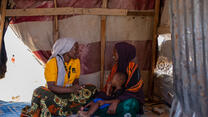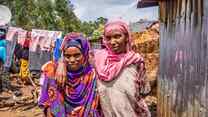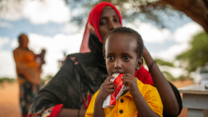WHO WE ARE
The mission of the International Rescue Committee (IRC) is to help people whose lives and livelihoods are shattered by conflict and disaster to survive, recover and gain control of their future. The IRC’s vision is to lead the humanitarian field by implementing high-impact, cost effective programs for people affected by crisis, and shape global policy and practice by sharing our learning and experience with others.
All IRC programs are designed to achieve meaningful change in people’s health, safety, education, economic wellbeing and ability to influence the decisions that affect their lives. The IRC maintains
a dedicated professional Research, Evaluation and Learning (REL) Technical Unit team to ensure that the organization is both outcomes driven and evidence based in its approach.
What do we mean by outcomes?
The IRC has made a commitment to focus on the impact we have on the communities we serve my making measurable improvements in their lives in five outcome areas: Health, Safety, Education, Economic Wellbeing and Power.
What do we mean by evidence?
Evidence refers to information that is systematically obtained and analyzed to determine whether, how and why a given intervention works. The IRC identifies, prioritizes and uses the best available information from research studies that indicate and explain causal impact. We generate evidence using rigorous methods that answer the most critical questions for action.
WHY OUR WORK MATTERS
The IRC is committed to delivering services that achieve results for people we serve by increasing the rigor with which we design, implement and evaluate our programs. In line with the IRC’s 2020 Strategy, programs are increasingly oriented around achieving specific priority outcomes and designed based on the best available evidence. In cases where evidence is weak or does not exist, the IRC conducts research to generate evidence.
We are rolling out new tools to measure program data and track the results of programming. We use cost data to compare the efficiency and effectiveness of different interventions and delivery models across contexts with the goal of improving accountability and determining the best use of available resources. These approaches enable the organization to help save lives and jumpstart recovery, use our resources most effectively, and achieve more sustainable solutions for the people we serve.
WHAT WE DO
IRC practitioners provide technical assistance to more than 30 country programs. Technical advisors are charged with staying abreast of the best available research and practices in their respective fields and sharing these with the IRC’s frontline teams. They also lead advocacy strategies to encourage partners and policy makers to adopt the interventions proven to be effective based on our research and experience.
HOW WE DO IT
The REL Unit team is working to enhance the IRC’s effectiveness by gathering and synthesizing the evidence base for what works; generating evidence where scant research exists; orienting the organization around outcomes; building new tools and systems to support measurement; and optimizing our use of resources.
Evidence Based
Understanding, referencing and applying the best available research evidence to our programs enables the IRC to strengthen its effectiveness and improve the lives of conflict- and disaster- affected people.
The IRC recognizes that delivering effective programming requires being clear about outcomes and grounding the choice and design of our interventions in theories of change.
Theory of Change
A theory of change is a set of evidence-based causal hypotheses that articulate the necessary steps required to achieve a specific outcome.
We generate evidence that:
- Addresses pertinent and pressing challenges to achieving our outcomes;
- Fills critical gaps in our current understanding;
- Informs decision making and can be translated into action; and
- Is relevant for humanitarian practitioners and policymakers.
This approach advances the IRC’s efforts to increase our own effectiveness and that of the humanitarian system as a whole.
In line with the above criteria, the IRC has selected four organizational research priorities:
- Education
- Family Violence
- Under-Five Mortality
- Cash Transfers
Since 2006, the IRC has completed, or is in the process of conducting, 74 research studies, including 32 impact evaluations. The number of IRC country program teams engaged in evidence generation also continues to grow. To date, the IRC has conducted research studies across 26 resource-poor, crisis- affected countries—Afghanistan, Burundi, Chad, Côte d’Ivoire, the Democratic Republic of the Congo, Ethiopia, Haiti, Iraq, Jordan, Kenya, Lebanon, Liberia, Malaysia, Nepal, Niger, Pakistan, the Philippines, Sierra Leone, Somalia, South Sudan, Syria, Tanzania, Thailand, Uganda, Yemen, and Zimbabwe—as well as in the U.S.
Outcomes and Measurement
The IRC recognizes the importance of tracking and measuring results to improve project design and implementation. To support this, the IRC is:
- Defining the outcomes that matter most to the IRC;
- Mapping the pathways to achieving these outcomes;
- Gathering the best available research evidence about what works to achieve these outcomes; and
- Transforming the evidence into information and tools for designing evidence-based programs.
Building on this base, we design outcome-driven and evidence- based projects by systematically using theories of change in all our new project designs. We then apply a set of standard indicators across the organization to monitor interventions and measure the extent to which we achieve our intended outcomes.
To determine the specific interventions that best achieve the intended outcomes, we draw on causal evidence from systematic reviews. In combination with context analyses, continuous client feedback and implementation research also inform our project designs.
One example of how the IRC shifted from a perceived “best practice” to an evidence-based approach is the change of focus from community-centered child protection interventions—which had no evidence, despite being widely practiced—to family-based child protection interventions, which were not widely practiced in the humanitarian sector, but had a strong evidence base in high- income countries. The IRC has since demonstrated the impact of family-based programs across three countries, becoming both a practice- and thought-leader in this sector and delivering better interventions to protect children.
Evidence Generation
The evidence base for interventions in crisis-affected contexts is thin. In cases where evidence is weak or does not exist, the IRC is committed to generating evidence. We focus time and resources on creating high-quality, meaningful and useful evidence across various contexts.
The REL Unit is leading the development and implementation of the organization’s Outcomes and Evidence Framework. In 2015, IRC researchers, technical advisors, and other program and technical staff worked to:
- Focus IRC interventions within 26 outcomes in the areas of health, safety, economic wellbeing, education and power, and five additional crosscutting outcomes focused on gender and one on minority groups;
- Create comprehensive theories of change and indicators based on best available evidence and practice associated with these outcomes; and
- Develop Evidence Maps that collate the available research and its applicability to the outcomes sought.
An interactive platform that draws together these tools for comprehensive humanitarian program design is live at oef.rescue.org.
Best Use of Resources
Humanitarian crises are growing at a time when resources are increasingly constrained to address them. Humanitarian agencies have historically not used cost data to compare the efficiency
or effectiveness of different programs or delivery models across contexts. As a result, humanitarian policymakers and practitioners have limited access to cost analyses that can help them make more informed decisions about how to spend scarce resources most effectively in a given context.
The IRC’s Best Use of Resources team conducts analyses that compare the costs of a program to the outputs produced (cost efficiency analyses) and the outcomes achieved (cost effectiveness analyses). These analyses will support the IRC to compare and cost different approaches and program impact to launch and advocate for humanitarian interventions with high return on investment.
The Best Use of Resources approach includes:
- Using cost analyses systematically in the IRC’s decision- making on new programs;
- Updating finance and budget-tracking systems to allow easier cost analysis for future proposals and programs;
- Publishing cost analysis reports for public use, positioning the IRC as a leader in evidence-based programming; and
- Raising awareness and use of cost analysis with other actors in the humanitarian sector, including donors and implementers.
To help the IRC understand how to apply financial resources to achieve the most effective interventions, the Best Use of Resources team published 10 cost-efficiency analyses of key IRC program activities, as well as three cost-effectiveness analyses of programs that produced impact evaluations. The Best Use of Resources team also developed the Systematic Cost Analysis (SCAN) tool to help programming teams quickly assess the cost efficiency of a given intervention or set of interventions. The SCAN tool will pilot simultaneously within the IRC alongside uptake by other humanitarian organizations and donors.
All IRC country programs are now in the process of realigning their program strategies to focus on outcomes and be based on evidence using the tools contained in the organization’s Outcomes and Evidence Framework. In addition, a new data platform—the Comprehensive Online Measurement and Effectiveness Tool (COMET)—is rolling out in 2016 and 2017 to IRC country programs.



